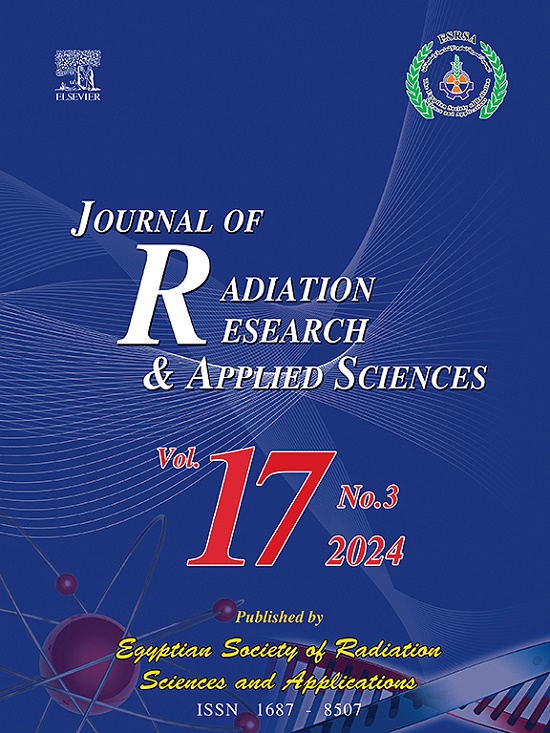利用x射线摄影和特征提取技术确定模拟生物组织的深度:用Bi-LSTM神经网络进行评估
IF 1.7
4区 综合性期刊
Q2 MULTIDISCIPLINARY SCIENCES
Journal of Radiation Research and Applied Sciences
Pub Date : 2025-03-08
DOI:10.1016/j.jrras.2025.101406
引用次数: 0
摘要
目的准确确定组织深度在医学成像和疾病诊断中至关重要,特别是对于复杂的生物结构。传统方法往往缺乏有效诊断和治疗计划所需的精度。本研究探讨了利用x射线输出和先进的特征提取技术确定心脏样组织深度。方法采用蒙特卡罗n粒子输运编码(MCNPX)对5、10、15和20 cm深度的模拟组织进行分析,并在70 keV下拍摄射线图像。提取了小波变换、灰度共生矩阵(GLCM)、灰度运行长度矩阵(GLRM)和分形分析等特征。使用双向长短期记忆(Bi-LSTM)网络预测组织深度,比较优化器Adam、RMSprop和SGD的性能。结果与其他优化器相比,随机梯度下降(SGD)优化器的预测精度更高。统计性能指标表明,SGD优于同类产品,在组织深度预测建模方面显示出更高的精度和可靠性。平均RMSE: 0.21155,平均MAE: 0.18522,平均MBE: 0.03400,平均MRE: 0.01422,平均MAPE: 0.01422,平均SMAPE: 0.01429。研究结果表明,Bi-LSTM模型在从放射图像预测组织深度方面具有很高的准确性。这项研究代表了医学诊断的重大进步,为长期挑战提供了创新的解决方案。通过将先进的成像技术与机器学习算法相结合,并利用MCNPX进行精确的模拟,可以开发出更准确、更可靠的诊断工具,最终改善患者的治疗效果。未来的研究可以探索这种方法的临床应用,并进一步完善模型以提高准确性。准确的深度测定不仅在医疗应用(如优化放射治疗中的辐射剂量)中至关重要,而且在各种工业环境(如无损检测和评估)中也至关重要。本文章由计算机程序翻译,如有差异,请以英文原文为准。
Depth determination of simulated biological tissue using X-ray radiography and feature extraction techniques: Evaluation with Bi-LSTM neural network
Purpose
Accurate determination of tissue depth in medical imaging and disease diagnosis is crucial, especially for complex biological structures. Traditional methods often lack the necessary precision for effective diagnosis and treatment planning. This study investigates the determination of heart-like tissue depths using X-ray outputs and advanced feature extraction techniques.
Methods
Simulated tissues at depths of 5, 10, 15, and 20 cm were analyzed using the Monte Carlo N-Particle Transport Code (MCNPX), with radiographic images captured at 70 keV. Features such as wavelet transform, Gray Level Co-occurrence Matrix (GLCM), Gray Level Run Length Matrix (GLRM), and fractal analysis were extracted. A Bidirectional Long Short-Term Memory (Bi-LSTM) network was used to predict tissue depth, comparing the performance of optimizers including Adam, RMSprop, and SGD.
Results
The results showed that the Stochastic Gradient Descent (SGD) optimizer achieved superior prediction accuracy compared to other optimizers. Statistical performance metrics indicated that SGD outperformed its counterparts, showcasing enhanced precision and reliability in predictive modeling of tissue depths. Mean RMSE: 0.21155, Mean MAE: 0.18522, Mean MBE: 0.03400, Mean MRE: 0.01422, Mean MAPE: 0.01422, Mean SMAPE: 0.01429.
Discussion
The findings demonstrate the high accuracy of the Bi-LSTM model in predicting tissue depths from radiographic images. This study represents a significant advancement in medical diagnostics, providing an innovative solution to longstanding challenges. By integrating advanced imaging techniques with machine learning algorithms and leveraging MCNPX for precise simulation, more accurate and reliable diagnostic tools can be developed, ultimately improving patient outcomes. Future research could explore clinical applications of this approach and further refine the models for greater accuracy. Accurate depth determination is crucial not only in medical applications, such as optimizing radiation doses in radiotherapy, but also in various industrial contexts, such as non-destructive testing and evaluation.
求助全文
通过发布文献求助,成功后即可免费获取论文全文。
去求助
来源期刊

Journal of Radiation Research and Applied Sciences
MULTIDISCIPLINARY SCIENCES-
自引率
5.90%
发文量
130
审稿时长
16 weeks
期刊介绍:
Journal of Radiation Research and Applied Sciences provides a high quality medium for the publication of substantial, original and scientific and technological papers on the development and applications of nuclear, radiation and isotopes in biology, medicine, drugs, biochemistry, microbiology, agriculture, entomology, food technology, chemistry, physics, solid states, engineering, environmental and applied sciences.
 求助内容:
求助内容: 应助结果提醒方式:
应助结果提醒方式:


